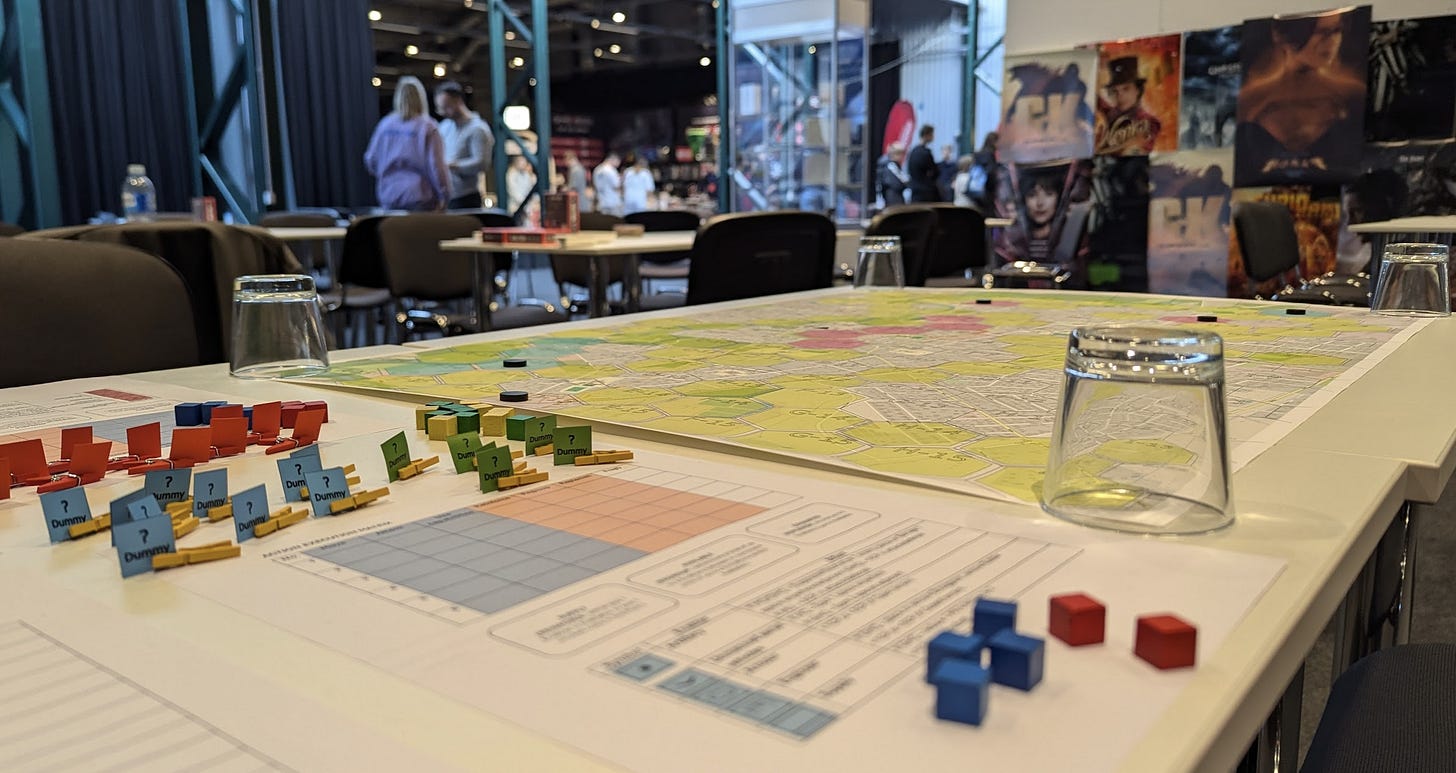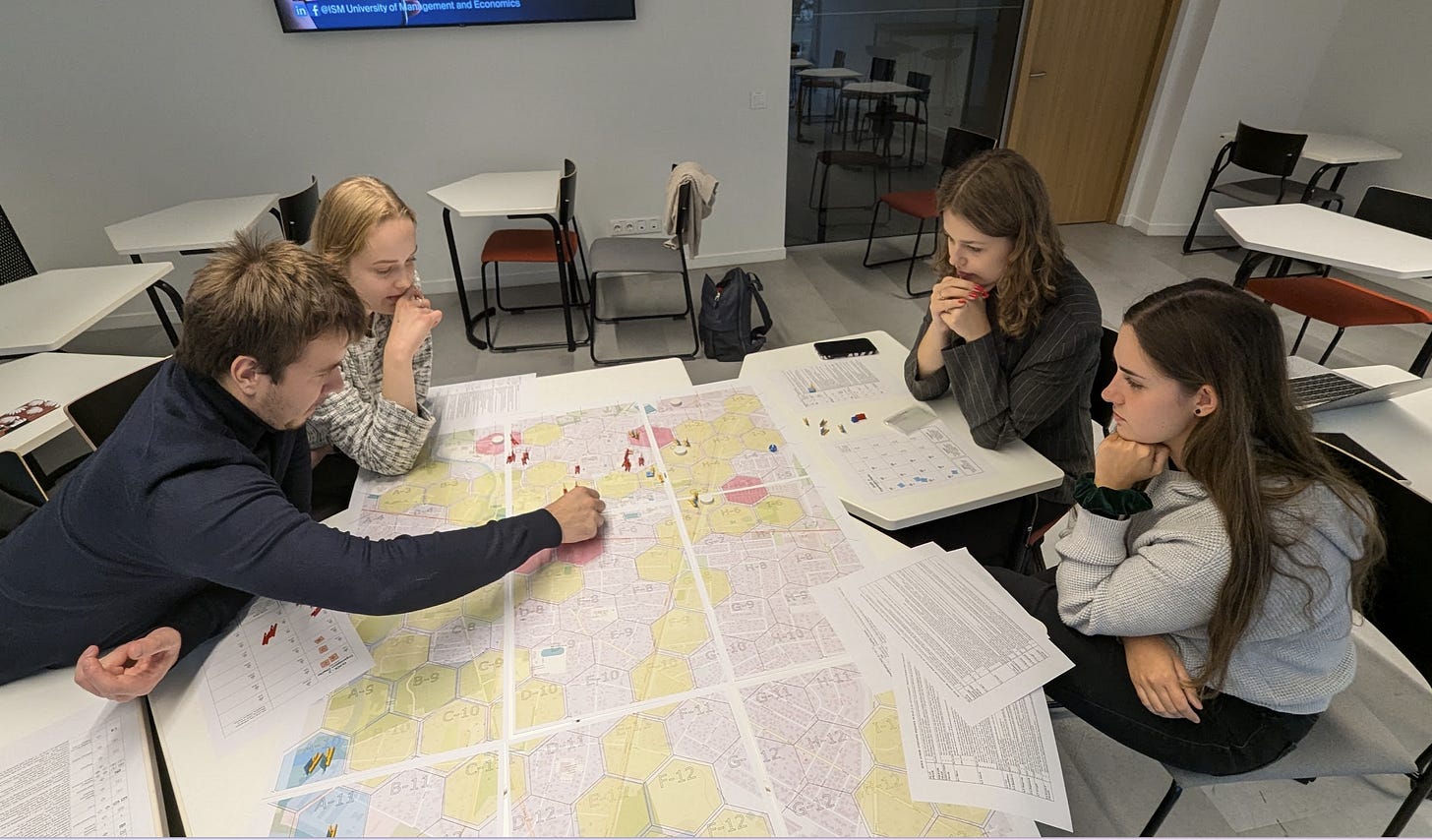How We Defended Marijampolė
Demonstrating wargaming through Quick Urban Integrated Combat Kriegsspiel designed by Brian Train
It’s near future. After a truce in Ukraine, Russia is rearming and reconstituting its military power, to prepare for a different war. This time in the Baltics. As part of the operation, 18th Guards Motor Rifle Division advances from Kaliningrad and its 275th Guards Motor Rifle Regiment is the first to reach the outskirts of Marijampolė and Šešupė river. Its level has risen due to the collapse of dam South of the town, and the invading troops have to cross the bridges to enter the town centre. Here, the Grand Duke Vytenis battalion and NATO forces of the enhanced forward presence battle groups await. Thankfully, nothing like this happened, and let us hope it won’t. However, preparing for the bad case and worst case scenario is important, and that is what wargaming can be so helpful with. Thus, the described situation unfolded on several tables at GameOn, a gaming culture event in Vilnius, Lithuania.
Setting the stage
Most of the GameOn event looks and showcases hobby video games, it also found space for conferences, board games and their history in Lithuania, engagement with history and learning about NATO, and thanks to a kind invitation from Artojas – wargaming. When we first started discussing, how it could look like in the event, I had no clear idea on what game to show, but I had some criteria in mind. First, the game should in one way or another have a link with Lithuania, to bring it closer to home. Second, it would preferably be not a commercial game, but a game designed for educational purposes. Third, I wanted to involve my students to help facilitate the game and also gain experience in this respect.
This September we launched Wargaming Lab, a new internal initiative at ISM University of Management and Economics. Here, we aim to build the wargaming capacity among the students and faculty, so that we could engage learning, research, and analysis utilizing the method. Thus, joining GameOn seemed like a great opportunity to start demonstrating what we do and raising the awareness of wargaming in general.
Luckily, September also saw Connections UK, where I had a chance to try Quick Urban Integrated Combat Kriegsspiel (or QUICK) designed by Brian Train. The scenario covered Daugavpils, a town near the border with Lithuania, and it gave me this idea of using the system for a Lithuania-based scenario, that could then be used to demonstrate how wargaming works for the local audience. Brian kindly agreed to share the game materials and provided additional advice along the way.
The QUICK
The game looks at modern urban combat and was originally designed to be used in a course held by the US 40th Infantry Division, and later adapted for the use by a Canadian batallion commander (QUICK Junior). We used this latter version of the game, as it fit the context better.
The game focuses on several key decisions that players (and commanders) would have to make:
How to assign, combine, and efficiently use different capabilities ranging from artillery to unmanned aerial vehicles, to supply, to… You get the idea. Capabilities are really at the core of keeping combat units in battle.
How to retain command and control during the battle, as Maneuver Elements are affected by their link to the grouping HQ (i.e. being in-command).
How to utilize Security Elements to hinder the opponent or to scout the territory.
How to account for variation in urban terrain.
How to plan the actions in advance.
One additional aspect that I found both informative and crucial is the inclusion of civilians. Leaving them aside in the context of urban fighting would distort the view that the players get.
Each side gets their HQs, Maneuver Elements, Security Elements, and capabilities, and then structures and deploys their force according to the scenario rules. Each side also gets action cubes of two colours that allows them to programme their six actions of the turn. This programming aspect may lead to quite a bit of pondering of how you expect that battle to change with the coming actions. You might as well end up without an opportunity to implement what you intended. You can also plan for it by devoting one action to restructuring the remaining ones, but do you really want to?
The decision space in the game is vast, while keeping rules overhead manageable. Yes, learning it takes a bit of time, but as the experience showed, playing through a lighter scenario can make the core of the game clear. Then if you start thinking about the different combinations of capabilities that could be provided to the different sides, inclusion of criminal elements, random events… The system provides a really good sandbox platform to explore and learn.
Defending Marijampolė
So, what did we do with Marijampolė, and why Marijampolė in the first place? As advised by the designer, a smaller urban settlement would work better, as well as a town with less variation in elevation. As Marijampolė is not too far from Kaliningrad and has a railway connection, it seemed like a good match. The presence of Grand Duke Vytenis logistic support battalion also fit well with the idea that the blue player would manage NATO eFP and Lithuanian forces.
After doing the initial work on the map and force structures, I’ve had an opportunity to work with my wonderful students Emilija Račkauskaitė, Gustė Kiškytė, Justina Godaitė, Povilas Masiliūnas, and Viltė Radzytė, to play through the scenario that let to some adjustments. In the end, we settled with two basic versions for demonstration purposes:
Involving one battalion-size Russian group vs. one company-size NATO and one company-size Lithuanian groups
Involving two battalion-size Russian groups vs. two company-size NATO and two company-size Lithuanian groups
Likewise, the two versions had different combinations of capabilities, but we generally tended to provide more artillery capacity to the Russian side and better supply to NATO/Lithuanian forces. For the objectives to take/defend, we selected the hospital, the prison, the railway station, and the industrial section close to the railway in the North of the town. For the southern part there were two key objectives – the military complex and the industrial section. We also set a different effect of the civilian population for the two sides, knowing the Russian way of war… The inclusion of civilians adds an additional dimension that is so needed in understanding and learning from war simulations, especially in the urban environment. Importantly, the effects are not coming as an exogenous factor, but directly results from the player’s actions. That’s a point recently wonderfully discussed by Andrew Olson in the The Convergence - An Army Mad Scientist Podcast.
With this preparation we got ready for demoing at GameOn. The turnout was not large, and that could be expected, as devoting several hours to a single activity at a (mainly video) gaming convention has a large opportunity cost. However, this allowed for a more involved teaching experience, with students and me getting hands-on into specific games, accompanying the players in their decision-making process.
As the different games unfolded, different approaches were explored by the players. From focusing on attrition and relying on artillery barrages to trying to outmaneuver and divide opponent troops. Yet, one thing that didn’t materialize in any of the five sessions played, was the use of smaller detachment units by the Russian side. Otherwise, the games mostly (but not always) moved from the attack in the north of the town (after crossing the Tarpučiai and Juknevičius street bridges), then along the railway track to the southern part of the town. In the end, the outcomes varied, no predetermined character emerged.
The game is more educational than analytical, and the decisions that the players must make are structured around the challenges that commanders would face. The nature of the game also gives a lot of space for exploration of how different capability compositions or contextual conditions could affect the battle and planning. I am looking forward to further exploring how and what the game can teach about urban operations planning, and the additional elements we haven’t been able to use until now. And, despite not having visited Marijampolė, I’m starting to feel that I know it quite well already.








